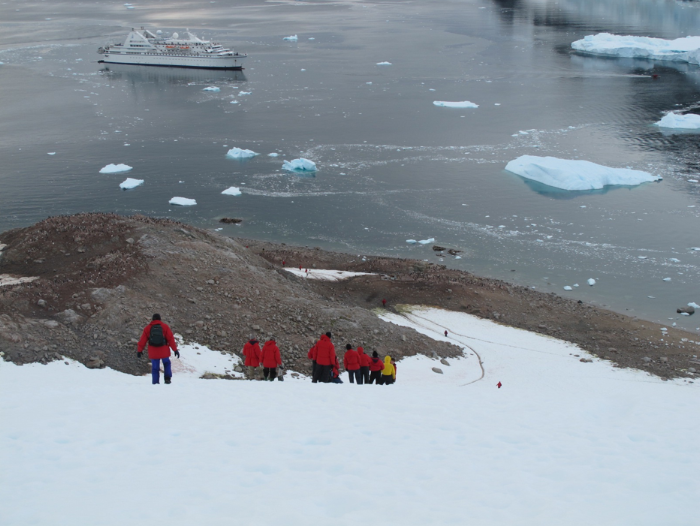Sliding Out of Control
Indeed, up to that point, the trip was all they’d hoped for. Then a few of their fellow travelers started sliding down the glacier. “It looked like fun,” Lucking said, and it was, until he started sliding out of control.
“I could tell about halfway down that I was in trouble,” he recalled. “I had spun around and I was sliding way too fast.”
Trouble, indeed. When he crashed into an ice bank at the bottom of the glacier, he shattered three vertebrae and was lucky not to be paralyzed on the spot.
Somehow, fellow passengers and crew members got him back to the ship and they sailed back to Ushuaia, their port in Tierra del Fuego. But it wasn’t easy. “I couldn’t get up without help,” Lucking said. “It just hurt too much. There was a lot of screaming.”

Fellow Antarctic tourists explore the South Pole glacier just before John Lucking took his turn sliding down the ice, the adventure that led to his back injury and his med-evac Lear Jet journey from Tierra del Fuego to John C. Lincoln.
Lucking is big on lessons. His next bit of dearly won advice is to make sure you don’t travel to isolated places alone. Make sure you travel with someone like Pit, he said. It’s not easy to call 911 from Antarctica.
“I never could have made it home alone,” Lucking said. “Pit was amazing. I have to give her so much credit. She figured out how to get me out; she got on the phone, she never gave up and she made all the connections.”
Pit called in their markers with the evacuation insurance plan – jumped through the hoops and cut the red tape – and commandeered, so to speak, a medical Lear jet, four pilots and a couple of crews of EMTs. They flew to Santiago, Chile, refueled in Guayaquil, Ecuador, changed crews and flew on to Brownsville, Texas. They went through immigration and cleared customs in Texas before traveling on and landing in the middle of the night at Sky Harbor, almost two days after leaving Tierra del Fuego.
Good Care at John C.
They knew they needed to come home to Phoenix; the only question remaining was which hospital to choose. “My parents had received good care at John C. Lincoln and I’d been there about six months earlier for stitches. It was near our home on North Central Avenue, so we checked into the Intensive Care Unit at the North Mountain Hospital at 2:30 a.m.”
Medical imaging the next morning showed a frightening blood clot around his fractured vertebrae, so immediate surgery was imperative. That’s when fortune smiled one more time on John Lucking.
On call was Gianni Vishteh, MD, a Barrow-trained trauma neurosurgeon who specializes in the most complex kinds of spinal injuries, and who responded immediately.
“John’s fractures were complicated by the fact that he has more than the usual level of osteoporosis,” a weakening of the bones that makes them more likely to fracture, Dr. Vishteh said. “After examining the MRI images of John’s injuries, we went quickly to surgery.”
There, Dr. Vishteh performed a multilevel laminectomy to stabilize Lucking’s spine and relieve pressure on the nerves in his spinal cord. The four- to five-hour surgery used screws and rods to fixate and fuse the three broken bones in the middle of Lucking’s back.
“No additional surgery should be needed,” Dr. Vishteh said, “but John needs to be followed with periodic medical imaging due to his osteoporosis. Because of that, there’s always a chance that his spinal bones could become unstable. It’s just something to watch.”
“After a few days in the hospital, where the nursing staff was just great,” Lucking said, “I came home and was flat on my back for a while. Then I started physical therapy two to three times a week where they taught me specific skills to strengthen my back.
“I progressively got better,” he said, “and while I’m not perfect now – I still have a few aches and pains –this isn’t going to slow us down.”
Indeed not. They’ve already been to Hawaii this year, and the rest of their 2011 calendar includes a Stanford University alumni trip to investigate ancient Middle Eastern cultural sites and artifacts in Iran and a few months later, snorkeling in Indonesia.
No, slowing down is the one thing that is most definitely not on the Lucking family agenda.
Visit JCL.com/northmountain for more information.
